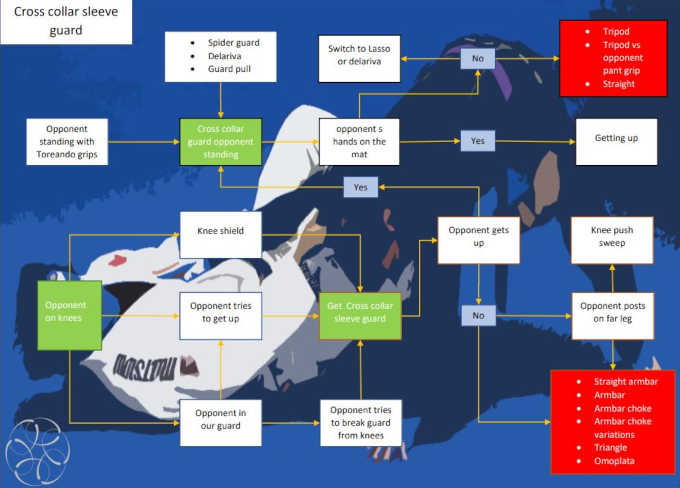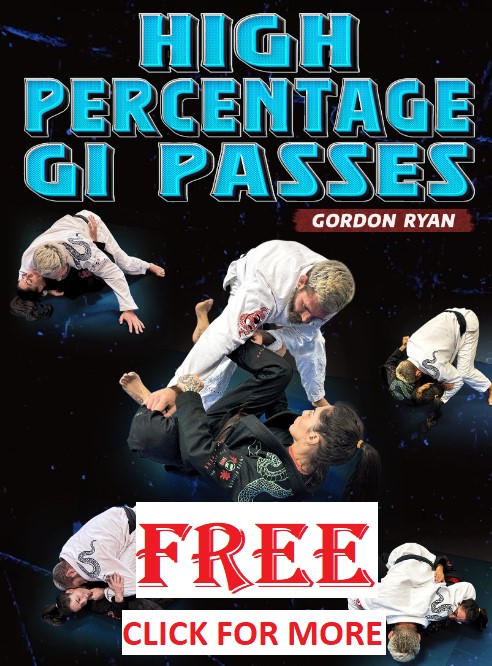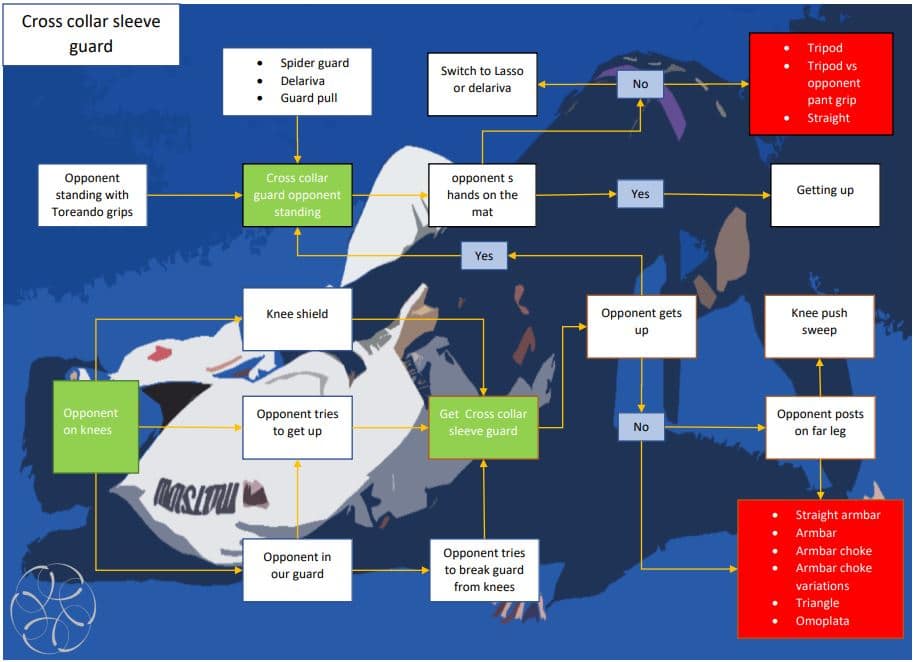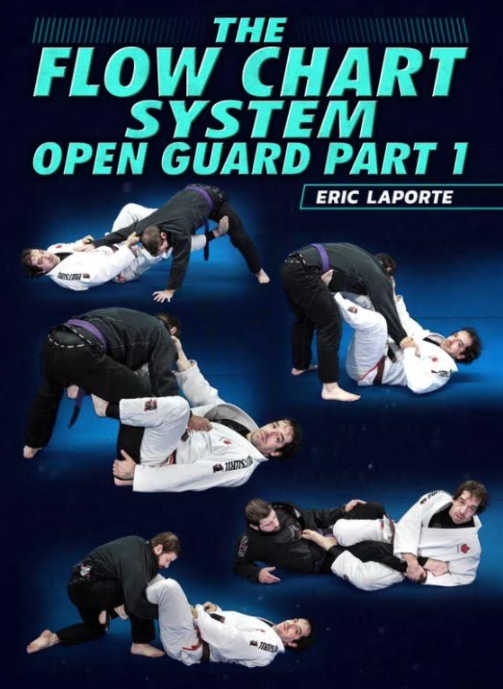
As a long-time martial artist, I have always been fascinated by how each academy’s curriculum and coaching methods differ from each other. I have been teaching Martial Arts for several years, and am known for thinking outside the box, putting emphasis on concepts rather than actual techniques.
As a seasoned teacher in many spheres of my life, I have always felt very fortunate to be able to share my knowledge and passion with others. From these experiences, I realized that everyone learns at their own pace and that we all have different needs and seek maximum improvement.
When I teach Brazilian Jiu-Jitsu, I use a structure I call “The Flow Chart System”. I released an instructional video on BJJfanatics.com based on that system. As they study it, people will get an initial glimpse at how the method works. I also added simplified Flow Charts to help them understand how the techniques are linked together. Given the complexity of Brazilian Jiu-Jitsu, flow charts have proven to be an effective tool for optimizing skills integration for students at all levels.
There are many benefits in using this structure, one being that it is very easy to understand. It is like looking at a map. You start with a technique or position, and then you go on from there. While learning BJJ, I always felt that we retain more information by associating techniques together, learning them as a sequence. For example, learning counters and sweeps as a reaction to your opponent’s actions, rather than learning everything independently. Too often, people learn a position but have no idea how or when to even get there. The Chart simplifies and answers many questions the student may have. Very often, my students look at the charts and remember what they learned in a class that took place weeks earlier.
Another benefit is that it is a great planning tool while preparing for a class or a seminar. The last seminar I gave was 3 hours of Open Guard. Using techniques taken from my Flow Charts, and regardless of their level, everyone really enjoyed it. Many were guests from other gyms and were surprised at how easy it was for them to understand and memorize the content. Some often send me videos to show me how much they improved. It’s also impressive to see how much they remembered.
A great way to improve fluidity and precision comes with drilling the sequences. In time, everything will fall into place. The transitions will become automatic while rolling or competing.
If you look at Karate, katas are often found in belt passage tests, putting emphasis on technique and movement reproduction. In Brazilian Jiu-Jitsu, I always enjoyed how liberal it was. Different body types, different levels of athleticism, and yet, everyone can find techniques they enjoy and that suit them. I am a firm believer that if an athlete understands the concept of a position or technique, he will not only learn it faster, but he will also be able to adapt it to his needs rather than simply copying a move.
Give this a try. I am convinced it will help most athletes in the growth and development of their martial art! Come and visit my blog at themartialartslife.net.
Eric Laporte


![Darce Choke Encyclopedia – Origins, Mechanics and Variations [2024] BJJ, choke, Brabo, BJJ Darce Choke, D'arce Choke, Darce BJJ Choke](https://bjj-world.com/wp-content/uploads/2017/11/JungPoirierLeeYahoo-218x150.jpg)











![Front Headlock and Turtle Escapes Brian Glick DVD Review [2024] Front Headlock and Turtle Escapes Brian Glick DVD Review](https://bjj-world.com/wp-content/uploads/2024/11/headlock-and-turtle-escapes-brian-glick-dvd-review-218x150.png)
![Basic Closed Guard Jasmine Rocha DVD Review [2024] Basic Closed Guard Jasmine Rocha DVD Review](https://bjj-world.com/wp-content/uploads/2024/11/basic-closed-guard-jasmine-rocha-dvd-review-218x150.png)
![Don’t Stand Up Chris Wojcik DVD Review [2024] Don't Stand Up Chris Wojcik DVD Review](https://bjj-world.com/wp-content/uploads/2024/11/dont-stand-up-chris-wojcik-dvd-review-218x150.png)
![EMU Guard 2.0 Benjamin Power DVD Review [2024] EMU Guard 2.0 Benjamin Power DVD Review](https://bjj-world.com/wp-content/uploads/2024/11/emu-guard-2-0-benjamin-power-dvd-review-218x150.png)
![The Whole Omoplata Enchilada Lyanne Perez DVD Review [2024] The Whole Omoplata Enchilada Lyanne Perez DVD Review](https://bjj-world.com/wp-content/uploads/2024/11/whole-omoplata-enchilada-lyanne-perez-dvd-review-218x150.png)
![No-Gi Defense Xande Ribeiro DVD Review [2024] No-Gi Defense Xande Ribeiro DVD Review](https://bjj-world.com/wp-content/uploads/2024/11/no-gi-defense-xande-ribeiro-dvd-review-218x150.png)
![Feet Finder Foot Sweeps Christian Ozbek DVD Review [2024] Feet Finder Foot Sweeps Christian Ozbek DVD Review](https://bjj-world.com/wp-content/uploads/2024/09/feet-finder-foot-sweeps-christian-ozbek-dvd-review-324x235.png)

![Efficiently Executing X-Guard Giancarlo Bodoni DVD Review [2024] Efficiently Executing X-Guard Giancarlo Bodoni DVD Review](https://bjj-world.com/wp-content/uploads/2024/09/efficiently-executing-x-guard-giancarlo-bodoni-dvd-REVIEW-100x70.png)

![Jeff Glover Deep Half Revolution DVD Bundle Review [2024] Jeff Glover Deep Half Revolution DVD Bundle Review](https://bjj-world.com/wp-content/uploads/2024/10/jeff-glover-deep-half-revolution-dvd-bundle-review-100x70.png)
![360 Degrees Guard Retention Thiago Abud DVD Review [2024] 360 Degrees Guard Retention Thiago Abud DVD Review](https://bjj-world.com/wp-content/uploads/2024/10/360-degrees-guard-retention-thiago-abud-dvd-review-100x70.png)





![Two Sides One Game Sweep and Pass Marcos Tinoco DVD Review [2024] Two Sides One Game Sweep and Pass Marcos Tinoco DVD Review](https://bjj-world.com/wp-content/uploads/2024/11/sweep-and-pass-marcos-tinoco-dvd-review-100x70.png)


![Dynamic Headquarters Passing Jason Rau DVD Review [2024] Dynamic Headquarters Passing Jason Rau DVD Review](https://bjj-world.com/wp-content/uploads/2024/10/dynamic-headquarters-passing-jason-rau-dvd-review-100x70.png)


![Giancarlo Bodoni DVD Bundle Essential Connections Full Review [2024] Giancarlo Bodoni DVD Bundle Essential Connections Full Review](https://bjj-world.com/wp-content/uploads/2024/09/giancarlo-bodoni-dvd-bundle-essential-connections-100x70.png)

![Basic Closed Guard Jasmine Rocha DVD Review [2024] Basic Closed Guard Jasmine Rocha DVD Review](https://bjj-world.com/wp-content/uploads/2024/11/basic-closed-guard-jasmine-rocha-dvd-review-100x70.png)





![Understanding The Distance On Top Gui Mendes DVD Review [2024] Understanding The Distance On Top Gui Mendes DVD Review](https://bjj-world.com/wp-content/uploads/2024/10/distance-on-top-gui-mendes-dvd-review-100x70.png)


![Eoghan O’Flanagan Bundle Down Right Sloppy Jiu-Jitsu Review [2024] Eoghan O'Flanagan Bundle Down Right Sloppy Jiu-Jitsu Review 2024](https://bjj-world.com/wp-content/uploads/2024/09/down-right-sloppy-jiu-jitsu-eoghan-oflanagan-bundle-100x70.png)